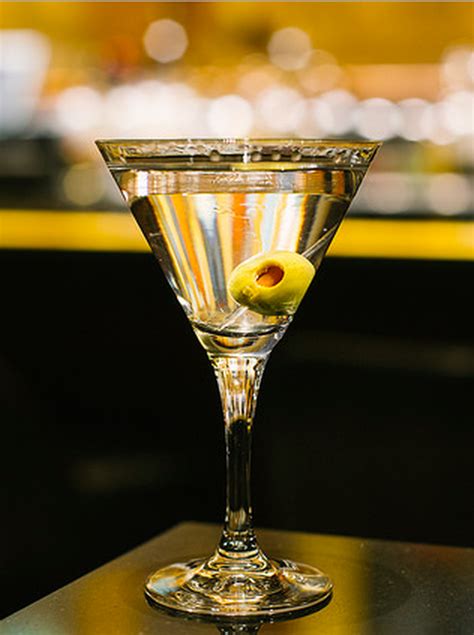During my freshman year of college at Emory University, I was assigned a faculty adviser, the medieval historian Dr. George P. Cuttino, Grand Marshall of the University and internationally known for his scholarship. He became my friend and mentor at a time when my mind was hungry and my palate thirsty for the new and unknown. Dr. Cuttino would feed my mind with the wisdom and lore of the Middles Ages but would also introduce me to my first martini.
It was 1980, and under the watchful eye of Dr. Cuttino, martinis were constructed of one-half ounce dry vermouth and two ounces dry gin, served in a Jefferson cup with a single olive and ice. Gordon’s was the gin of choice at first, until Bombay Sapphire became available. The order of construction was precise as a scholastic argument: olive, ice, vermouth, and then gin. Mixing began with the most inexpensive item and ending with the most expensive, just in case an error was made and the concoction had to be tossed out. These days the ice is added last, unless I am outside the home enjoying a martini straight up.
I still possess the measuring jigger out of which my quest began some 34 years ago, along with a set of pewter Jefferson cups Dr. Cuttino gave me as a graduation present in 1984. Dr. Cuttino’s home in the leafy neighborhood around Emory was filled with his mementos of history, both his personal history beginning in Newnan, Georgia, as well as an extensive collection of memorabilia drawn from his teaching. Martinis were served in cold pewter cups with cheddar cheese straws, frivolity, friendship, and even more, respect and love.
I was the last person to be with Dr. Cuttino, Professor Emeritus of Medieval History at Emory University, when he passed away at Piedmont Hospital in 1991. He was like a father to me in many respects; he had over the years become much more than a mentor. To this day, I enjoy every martini in honor of his memory. That may explain why I’ve remained engaged in a search for the perfect martini ever since.
I must admit that my search for the perfect martini has evolved along the way. While I was once a gin aficionado, an observant wife alerted me to the fact that gin altered my personality. She said it made me mean and she was right. Thus, to save my marriage and myself, I switched to vodka in 1998. All is well now. My bar side mantra is “Ketel One martini please, straight up with a twist, dry,” my performative utterance towards martini nirvana. (Ketel One Vodka is distilled from 100% wheat in copper pot stills in the Netherlands.)
European and Asian martinis generally are horrid. In Europe they are so loath to part with ice a martini is never cold enough, except at the swankiest of 4-star hotels. In Asia. they are served warm and oily, with half vermouth and half cheap Russian vodka plus some components unknown in Western society. (In Vietnam, I drank some liquor in which dead sea horses were floating. I swear!)
Along the way I realized the best martini was to be found the New World. The martini of The Lambs Club in New York City, with its classically shaped glass filled with cold, slightly iced, and pure mixture, has a magical taste. The vermouth is poured in, swirled, and dumped right back out. Sparks Steakhouse in New York rates highly or, better yet, Mastro’s Steakhouse in Chicago where the martini arrives still in its embryonic shaker with ice, that for some reason never melts. The result is a double-double martini of memorable proportion. The honorable mentions are many, though I’ll never forget La Paloma in Tucson, Bern’s Steakhouse in Tampa, and Durant’s in Phoenix.
The most perfect martini I’ve yet discovered is constructed at the Tutwiler Hotel in Birmingham, Alabama by bartender Allan Ellis. Alan, a longtime mainstay at the Tutwiler lounge, produces a mysteriously cold cocktail. Unlike most martinis, Alan’s does not have a floating layer of ice chips left over from its birth in a cocktail shaker, yet it remains extraordinarily cold.
Ice chips normally ruin the consistency of the beverage, as well as watering the drink down in its initial stages, during the incremental sipping. It’s all very scientific, of course. But Alan’s martini is quite cold without the ice flow on the top. Alan uses the pour, swirl and dump method I prefer: He wistfully looks at the vermouth bottle on his way to retrieving a cold martini glass. There are no errors in the conception of Alan’s martini, thus no distractions in its bite or erroneous flavors.
I’ve had martinis all over the world, but the best one is only a few hours driving time away from my home in Atlanta.
Having brought this train into the station, I must admit my quest for the perfect martini has brought me full circle. While I give the Tutwiler its well-earned reward as a present day marvel of the most perfect martini, I have come to to realize that my quest for the most perfect martini will never be complete but will remain unending.
The perfect martini is a combination of ingredients, construction, time and atmosphere. It cannot be repeated in any one location nor at ay one time. It changes with company or companionship, age, music, nostalgia, mood, weather, and virtually any other factor of a particular time and place.
In hindsight now, sitting in a dusty room with classical music playing, with Dr. Cuttino seated across from me, sharing gossip of grave historical value, comforted by the warmth of a pewter cup containing perfectly mixed gin, feeling sheltered from all evil, sensing that God watched over both of us, I was experiencing life at its finest in the steadfastness of our friendship, meaning that this martini may have been the most perfect ever.
